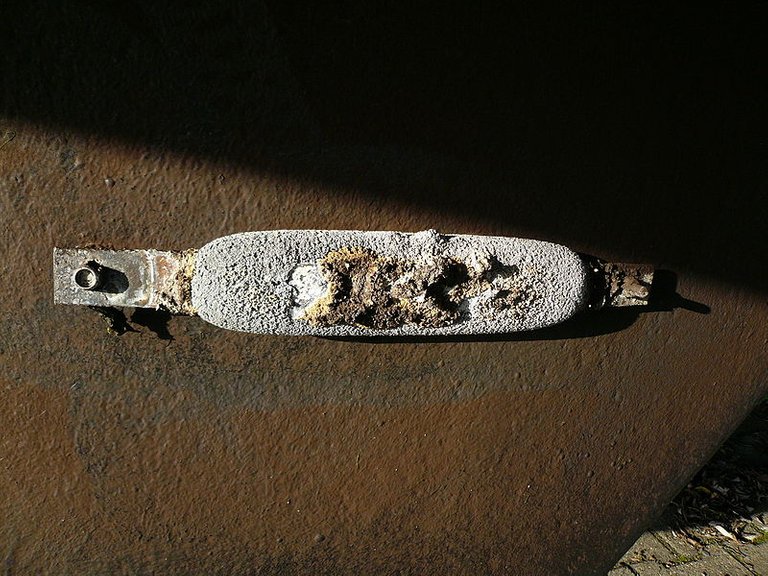When a welder finishes a job in his workshop, the next thing to do is put on some paint. Several coats of paint on the work gives the job a nice and appealing look. Have you tried to consider what else could be the reason for the coat(s) of paint? Apart from the aesthetic factors, another reason for applying paint is to protect the metal from interacting chemically with the environment and thus corrode. If this is not done, we all know what would become of the metal work in a few days.
The negative economic impacts of corrosion has made it a thing of concern for anyone or any process that involves the use of metals. And because of the fact that metals are widely used in if not all, almost all sectors of human endeavor, the case of corrosion cannot be shoved aside.
In my last article, I highlighted the different forms by which corrosion can occur and the signs that would surface when this occurs. I also was able to state the difference between corrosion and rusting. Just like I promised, today I would be discussing the various ways by which corrosion can be combated (with special reference to the cathodic protection methods).
Just like an adage says “prevention is better than cure”, preventing corrosion is one of the things that are taken into consideration when designing a machine part or structure or whatever is made of metal. Not preventing it from corrosion is simply going to shorten the lifespan of the material and it would be a loss to whoever owns it. However, as much as prevention is good, cure can also be done to prevent further damage. So either way, the point is to keep the thing in question in good condition.
Without further ado, let’s see how corrosion can be combated/prevented.

Say no to corrosion. image created by me
Meet the warlords that are against corrosion
Depending on the environment a material is meant to be used in, different corrosion protection methods are applied to the material. The ultimate goal is to prevent or stop the corrosion process, the means may differ.
Coating
One of the most common ways to prevent corrosion is to coat the metal with a protective material which would shield it from contact with the environment. The welder I mentioned earlier did not paint the work just for the sake of aesthetics only, he also did it to prevent corrosion.
Take for instance two steel metal sheets of the same composition and size are placed in a moist environment. If one is painted (say, with a gloss paint) and the other left bare. After a while (days or weeks), the bare metal would have traces of rust already formed on its surface while the painted one would still be fine simply because the paint has prevented contact between the metal and the moist environment.
Use of coating to protect metal from corroding is considered as a passive method of corrosion protection because it does not influence the corrosive property of the metal or the corrosiveness of the environment. This way, if for any reason (fire, mechanical wear or a more corrosive substance is introduced), the coat is removed, corrosion process will set in in no time.
There are various classifications of coatings that are used on metals for the sake of corrosion protection. Ranging from oil-based to water based coatings, and also hot waxes in which the metal would be dipped into.
Plating
This method is quite similar to coating as it involves application of another substance on the metal to prevent contact with the environment but in this case, the substance is another metal.
Plating involves the introduction of another metal on the surface of the original metal. Usually, this gives an impression that the material is made of the metal on the surface whereas the bulk of material is the one underneath. This process, just like coating also presents an aesthetic feel.
I bet it wouldn’t be a shocker to you if I told you that most “gold” jewelry are actually “gold plated” i.e most of the jewelry is another metal with gold plated on it. That is the reason most of these inexpensive jewelry fade with time.
Yeah, gold is expensive and if you got it so cheap, you actually have a gold plated one.
Plating can be done in several methods depending on the final result required and the type of metal to be plated on the base metal. The most common however being the electroplating which involves the use of electricity to deposit a metal on another in an electrolytic setup known as electrodeposition.
Other methods include mechanical plating which simply involves cold welding of the plated metal to the base metal. Simply put, mechanical plating is plating by impact. Another method; electroless plating which employs the use of chemical reactions (not involving electricity as in electroplating). Dipping the metal into a bath containing another metal is also a method of plating called hot dipping.
Environmental modification
Sometimes, when the type of metal to be used for a particular operation cannot be altered by any of the above mentioned methods maybe because it is the best type to be used and there is no other better alternative, the environment would be considered for alteration or modification to avoid the corrosion of that metal.
Take for instance, the blades of a turbine in a steam power plant. The blades come in contact with water in the form of steam throughout the operation. If the water is fed in the normal state, corrosion would set in just soon enough because as we all know, water and air are one combination of corrosion activators. In order to prevent this, the water is first treated to remove the constituents that can cause corrosion. That way, the steam cannot react with the metal blades and cause corrosion.
Environmental modification could simply mean channeling the corrosion causative away from the material to reduce or prevent corrosion.
Material selection
Well, this is more of like the easy way out of the corrosion issue because it involves the material itself. No material is 100% corrosion resistant but some metals are resistant to some conditions that would cause corrosion for other materials.
Take for instance the case of roofing sheets in Ibadan Nigeria I mentioned in my previous post, the use of aluminum roofing sheets have proved that aluminum is resistant to corrosion under the same conditions and thus, people have started using aluminum roofing sheets instead. That way, corrosion is prevented by matching materials and their suitable environments (simple and sweet!).
Corrosion Inhibitors
Examining the English word “inhibitor”, it simply means something that prevents or slows down a process. Just like a catalyst speeds up the rate of a reaction, inhibitors do the opposite.
A corrosion inhibitor can then be described as any chemical (usually added to a fluid) that can prevent or slow down the corrosion process in a metal. These inhibitors take the stage by reacting with the metal surface (most times) or sometimes the environment thereby causing the corrosion process to be impossible.
Most of the paint coatings used for metal painting contain inhibitors. Also, fluids like engine oil, hydraulic fluids, and coolant fluids contain inhibitor compounds which help to prevent corrosion of inner parts of engines.
Cathodic Protection
At the beginning of this article, I mentioned that we were going to be giving special reference to cathodic protection methods of corrosion. Well, here we are.
You might want to ask, what’s so special about this method of corrosion protection that I would want to talk extensively about it? Well, let’s wait and see.
For metals in environments such as water and soil, the type of corrosion common is galvanic corrosion and just like I mentioned in my previous article, it occurs just like the electrochemical cell which involves the transfer of electrons from one metal to another. Sometimes, the same metal may have different points which act as the anode and cathode for the electrochemical cell or more specifically speaking, the corrosion cell to be complete. Simply put, galvanic corrosion is a case of electrochemical cell in the wrong place.
Ships, pipelines, underground and overhead tanks, reinforcement steel for concrete and other materials that fall in such category are prone to galvanic corrosion and if not properly taken care of, serious casualties or economic loss could be recorded. In order to combat galvanic corrosion (usually on a large scale) cathodic protection processes are applied.
What is cathodic protection you might say, here you go!
If you take a look at the other corrosion protection methods I highlighted, they are all aimed at preventing the process of corrosion but in the case of cathodic protection, the mechanism still goes on but not at the detriment of the metal to be protected.
If you take a critical look at the galvanic cell, the anode is always the one that reduces in size i.e corrodes while the cathode remains in a good state or even increases in size. Well, this goes to say that the reaction favors the cathode. If that’s is the case, why not find a way to make our (by our, I mean the material we want to be protected against corrosion) material the cathode in the corrosion cell, that way, it wont corrode.
Nice idea right? This is what Sir Humphry Davy thought of in 1824 and what later developed to the principle of cathodic protection. Cathodic protection is simply a method of combatting corrosion by making a material of interest the cathode in the corrosion cell thereby stopping the corrosion of such material. More of like a case of “if can’t beat them, join them!”
Cathodic protection can be applied to materials in two ways namely; the galvanic anode method and the impressed current method. In this post, I would be discussing the galvanic anode method.
Galvanic anode method of cathodic protection follows one simple principle based on the galvanic series which is simply an arrangement of metals in order of their electronegativity(or nobili). Usually, galvanic series change depending on the type of electrolyte in question but for the sake of this post, we would be considering sea water.
simply put, metals are more reactive than one another and when you arrange them in order of decreasing reactivity based on a particular electrolyte, you have the galvanic series. Kapish!
Now, combining the galvanic series, galvanic cell and corrosion principles, you have the idea of galvanic anode cathodic protection method.
The galvanic anode method simply involves attaching a material that is higher in the series (more electronegative) to the material in question. The consequence of this is that the metal that is attached acts as the anode in the corrosion cell and thus, corrodes instead of the material of interest. As a result of that mechanism, the galvanic anode process is called the sacrificial anode cathodic protection method. Well, quite obviously, the anode is used as a sacrifice (literally) to save the metal of interest.
As long as the sacrificial anode is present, the corrosion cell is complete and the anode corrodes.
Ships and boats apply this method of corrosion protection to prevent corrosion. If you look closely at the ship hull beside, you would see some white patches. These are zinc blocks that are used as sacrificial anodes to prevent corrosion of the ship’s metal body. Sacrificial anode cathodic protection systems find application in a lot of situations where the material to be protected is fairly large.
The galvanic anode system is quite easy and simple to implement and costs fairly low too. The only thing needed is to check on the sacrificial anodes and change them when they finally corrode completely.
Protecting metallic materials and structures against corrosion is a very important activity in order to prevent wastage of products and/or human and economic fatalities. Whichever method of protection to be applied is chosen based on the type of metal, the environmental condition and sometimes the economic situations available.
One of the wonderful corrosion protection methods is Galvanizing of steel which. It is quite fascinating to me because it combines two corrosion protection methods – plating and galvanic cathodic protection. By covering the steel with zinc (or tin) the metal is plated but in case the material comes in contact with an abrasive surface which scratches off a zinc layer, the resulting pair of Zinc and Steel can form a galvanic cell in which case the zinc would still be the anode. Either way, the steel core is protected from corrosion and lasts long in service.
CONCLUSION
Whether you would be coating, plating, using inhibitors, modifying the environment, selecting resistant materials or applying cathodic protection to a metallic piece, the main focus is to prevent corrosion of the metal.
Corrosion protection methods are not new as many of them can be directly seen in our everyday lives in the things we see and use. From the silver plated spoons to our galvanized steel pipes to the stainless steel plates we use (yes, this falls under material selection). We are in dire need to protect our metal equipment from the cold hands of death (in this case, corrosion).
If you noticed, I didn’t mention the second method of cathodic protection. Well, that is what I would be discussing in my next post. I actually did a project on that method and I would be talking (or writing ) extensively on that subject matter.
A big thank you to all my readers and i am always overwhelmed by your comments. well, lets do it again.
Cheers!
REFERENCES
Corrosion prevention methods
Corrosion prevention - the balance
Corrosion protection methods
Corrosion protection
Corrosion protection methods
Galvanic cathodic protection
Cathodic protection
Galvanic series
Galvanic corrosion- NACE
Sacrificial anode cathodic protection


.jpg)


That a great post here @rharphelle no wonder those so called gold watches, chain and other jewelries....are all fake. Oh elctroplating is coop tho. Also i love when my metals are painted basically for aesthetic tho. Thanks for this great write up. We are ending corrosion...lol
yes we are!
thanks for dropping by
Wow! Your pen is sure dripping with intellectual and captivating posts. Thanks, and watching out for the cathodic protection method part.
Nice job you've done here!
Haha, i am so flattered right now. Thanks for the kind words.
I should be done with the other part in a few days.
I hate the way copper cable corrode, especially when exposed to the elements. It is an excellent conductor but easily corroded.
copper still possess a good level of corrosion resistance and can "survive" in environments steel cannotsource. maybe the enviroments are quite very favorable to corrosion
This is a well articulated post explaining in details the methods of preventing corrosion. You had me glued all through.
I guess these methods are best suited for different purposes depending on the situation in question.
But Based on the fact that galvanizing combines two corrosion methods, can we say it is the best protection method?
Smile, perhaps I should wait for the second cathodic method before asking that question
Kudos
Yeah, just wait
thanks for reading
Always producing contents with high quality.... I must say you are really blessed.
This is very detailed
My time reading this was not in vain, richer in knowledge now.
Nice one bro
thanks for your kind comments, i am flattered
Of all of the methods, which will you say is the best and cost effective?
well, that depends on the environment the material is meant for and the size and type of material you are dealing with.
However, cathodic protection methods have proved to be very efficient and when used with other types such as coating, the efficiency is further increased
Oh, thanks for the insight.
Hi @Rharphelle
You did I good job man... From your introduction about why a welder paints.. I was already thinking of plating and you killed if man
Many of us fall for that, in the name of having good both they coat it for our own good I guess
Thanks for sharing man
you're welcome
thanks for visiting
Hmmm, @rharphelle is here again... Out of all the listed corrosion prevention method, I think material selection is better because i love it when something is simple and sweet lol... What do you think??
lol. It all depends on the application though. sometimes, the most corrosion resistant metal for an environment might not be fit for other requirements such as strength and the likes.
Okay sir, understood.
Hi @rharphelle!
Your post was upvoted by utopian.io in cooperation with steemstem - supporting knowledge, innovation and technological advancement on the Steem Blockchain.
Contribute to Open Source with utopian.io
Learn how to contribute on our website and join the new open source economy.
Want to chat? Join the Utopian Community on Discord https://discord.gg/h52nFrV
Well done @rharphelle! You successfully guessed the match result.
Click on the badge to view your Board of Honor.
Do not miss the last post from @steemitboard!
Wawu... Like seriously? @rharphelle
lol, whats that?
You're good
Well done @rharphelle! You successfully guessed the match result.
Click on the badge to view your Board of Honor.
Do not miss the last post from @steemitboard!
Well done @rharphelle! You successfully guessed the match result.
Click on the badge to view your Board of Honor.
Do not miss the last post from @steemitboard!
Well done @rharphelle! You successfully guessed the match result.
Click on the badge to view your Board of Honor.
Do not miss the last post from @steemitboard!
Do you like the SteemitBoard Corld Cup Contest?
Vote for @steemitboard as a witness and get one more award!